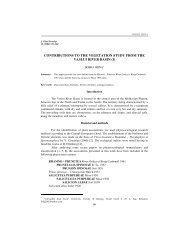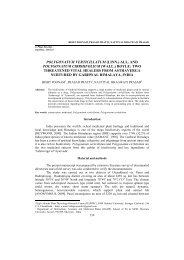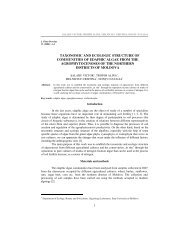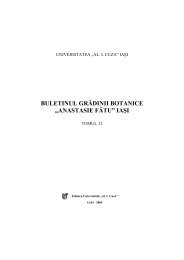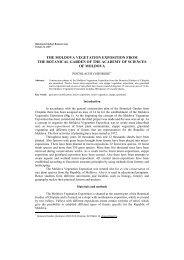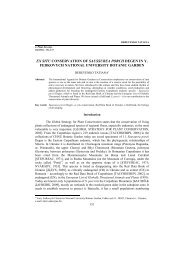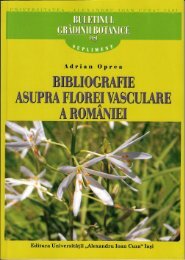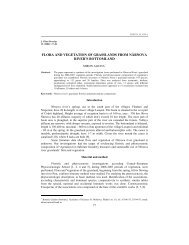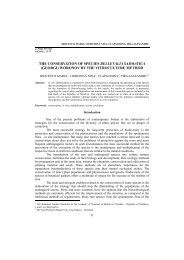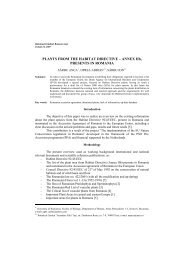importance of mushroom colections used for mycology knowledge
importance of mushroom colections used for mycology knowledge
importance of mushroom colections used for mycology knowledge
Create successful ePaper yourself
Turn your PDF publications into a flip-book with our unique Google optimized e-Paper software.
ŞESAN TATIANA EUGENIA, TĂNASE CĂTĂLIN, BÎRSAN CIPRIAN<br />
J. Plant Develop.<br />
16 (2009): 109–123<br />
IMPORTANCE OF FUNGAL COLLECTIONS FOR MYCOLOGY<br />
IN THE FRAME OF BIOLOGICAL TEACHING<br />
ŞESAN TATIANA EUGENIA 1 , TĂNASE CĂTĂLIN 2 , BÎRSAN CIPRIAN 3<br />
Abstract:<br />
The paper presents the <strong>importance</strong> <strong>of</strong> fungal collections <strong>for</strong> <strong>mycology</strong>, <strong>for</strong> systematical studies upon<br />
fungi taxa, <strong>for</strong> preservation <strong>of</strong> fungi species, <strong>for</strong> in<strong>for</strong>mation transfer <strong>of</strong> the taxonomical data from a<br />
generation to another generation or elaboration <strong>of</strong> scientifical papers etc. A list <strong>of</strong> the most important<br />
collections from entire world and from our country is also presented.<br />
Key words: fungi, collections, <strong>mycology</strong>, herbarium.<br />
[HAWKSWORTH & MOUND, 1991] reported that the existence <strong>of</strong> collections<br />
representing the main component <strong>of</strong> the transfer system <strong>used</strong> <strong>for</strong> manipulation <strong>of</strong><br />
in<strong>for</strong>mation about biodiversity.<br />
Now, there are registered only 11.500 taxons from all 345.000 taxons <strong>of</strong> known<br />
fungi, representing only 3% from their total and only 0.8% from their estimate number,<br />
approximately 1.5 millions [HAWKSWORH, 1991; TĂNASE & ŞESAN, 2006; ŞESAN &<br />
TĂNASE, 2006].<br />
The <strong>importance</strong> <strong>of</strong> these collections [CONSTANTINESCU, 1972, 1978;<br />
HAWKSWORTH, 1991; STOICA & colab., 2002; KIRK & colab., 2001/republished 2004;<br />
TĂNASE & ŞESAN, 2006; ŞESAN & TĂNASE, 2006 etc.] was been evidenced into<br />
following directions:<br />
– priority <strong>of</strong> preservation <strong>of</strong> species with a major <strong>importance</strong> <strong>for</strong> ecosystem biodiversity<br />
(keystone species);<br />
– collections existence assures the time and materials <strong>for</strong> specialists <strong>of</strong> this domain;<br />
– the bringing up to date <strong>of</strong> binary classified list <strong>for</strong> all taxon types;<br />
– the assurance <strong>of</strong> in<strong>for</strong>mation transfer concerning taxonomical data from a generation to<br />
another;<br />
– the initiation and improvement <strong>of</strong> <strong>knowledge</strong> about these <strong>for</strong> specialists in this domain;<br />
– the realisation <strong>of</strong> biological material changes;<br />
– analysis <strong>of</strong> biological material;<br />
– the comparison <strong>of</strong> in<strong>for</strong>mation from different sources;<br />
– elaboration <strong>of</strong> scientific paper <strong>for</strong> reviews which publish this kind <strong>of</strong> in<strong>for</strong>mation;<br />
– to <strong>for</strong>m deposits <strong>for</strong> a huge quantity <strong>of</strong> in<strong>for</strong>mation concerning distribution and ecology<br />
<strong>of</strong> fungi.<br />
The collecting an preservation <strong>of</strong> fungi <strong>for</strong> mycological collections<br />
[CONSTANTINESCU, 1972, 1978; TĂNASE, 2002; KIRK & colab., 2001/2004, p. 120;<br />
ŞESAN & TĂNASE, 2004] is an important desideratum <strong>for</strong> biodiversity conservation.<br />
1 University <strong>of</strong> Bucarest –Faculty <strong>of</strong> Biology<br />
2 “Alexandru. Ioan Cuza” University <strong>of</strong> Iaşi – Faculty <strong>of</strong> Biology<br />
3 “Anastasie Fătu” Botanical Garden <strong>of</strong> Iaşi<br />
109
IMPORTANCE OF FUNGAL COLLECTIONS FOR MYCOLOGY IN THE FRAME OF …<br />
The dried macromycetes specimens kept carefully preserve their microscopic<br />
structure. This aspect makes them adequate <strong>for</strong> important mycologic collections or those<br />
<strong>used</strong> <strong>for</strong> their scientific and didactic purpose.<br />
For the specialists who collect fungi, especiually <strong>mushroom</strong>s, <strong>for</strong> a collection, they<br />
have to follow some instructions:<br />
– preservation has to be realized without affecting the specie continuity inside <strong>of</strong><br />
collecting area;<br />
– quality <strong>of</strong> preserved material – this material have to be collected in successive stages<br />
<strong>of</strong> development, including the stages with mature spores; it is recommended to collect<br />
only young and mature exemplars (cap, stalk, ring, volva, and gills), without free larva<br />
and snails. The <strong>mushroom</strong>s could be collected especially during spring, summer and<br />
autumn. Sporiferous bodies will be cleaned, throuing soil particles. It is recommended<br />
to be avoid an excessive manipulation because this material is very fragile (many<br />
elements <strong>used</strong> <strong>for</strong> identification could be destroyed).<br />
– quantity – it will be collected enough biologic material only where this is possible; the<br />
collecting have to be done into substrate <strong>for</strong> a minimum deterioration <strong>of</strong> their structure.<br />
– notes about collecting areas – have a major <strong>importance</strong> <strong>for</strong> species identifications; this<br />
in<strong>for</strong>mation have to mentioned specific characteristics <strong>of</strong> fungi/<strong>mushroom</strong>s, especially<br />
those one which are deteriorated through drying process (dimensions, <strong>for</strong>m, colour,<br />
texture, taste, smell etc.). The notes have to registered in<strong>for</strong>mation about collecting<br />
area, association mode <strong>of</strong> individuals. It is recommended that collecting to be realized<br />
together with substrate, especially <strong>for</strong> parasite species. Species <strong>of</strong> lignicolous<br />
<strong>mushroom</strong>s, which growing up usually on wood, will be collect with their substrate.<br />
The same recommendations are available <strong>for</strong> saxicolous lichens.<br />
– colour photos – will be done <strong>for</strong> all collected individuals, and these photos will be<br />
added to the „notes about collecting area” to completing in<strong>for</strong>mation about:<br />
fungus/<strong>mushroom</strong> characteristics, their distribution and ecology.<br />
– necessary equipment – is composed by a basket, paper bags or waxed paper bags <strong>used</strong><br />
<strong>for</strong> <strong>mushroom</strong>s wrapping, each <strong>of</strong> them in different bags, especially <strong>for</strong> individuals<br />
with large sporiferous bodies; also, the collecting will be done in metallic or plastic<br />
boxes <strong>for</strong> <strong>mushroom</strong>s with medium dimensions, and in tubes or small boxes <strong>for</strong> little<br />
<strong>mushroom</strong>s. There is no recommended the depositing <strong>of</strong> <strong>mushroom</strong>s in plastic bags.<br />
For separation <strong>of</strong> <strong>mushroom</strong>s away from their substrate we have to use knives,<br />
scissors, mallet, all <strong>of</strong> them adequate <strong>for</strong> this kind <strong>of</strong> actions.<br />
Chemical characters <strong>of</strong> pulpous <strong>mushroom</strong>s have a very important role in their<br />
macro- and microscopic determinations [TĂNASE, 2002; KIRK & colab., 2001/2004, p.<br />
120; ŞESAN & TĂNASE, 2004].<br />
The ferrous sulphate (FeSO 4 ) is <strong>used</strong> both as aqueous solution 10% and as<br />
crystals. The using <strong>of</strong> crystal depends on age and texture humidity (pulp, flesh) which are<br />
already tested. This is <strong>used</strong> <strong>for</strong> deterioration <strong>of</strong> some species from Russula and Boletus<br />
genera.<br />
Phenol (phenol acid in aqueous solution 2%) is <strong>used</strong> <strong>for</strong> identification <strong>of</strong> some<br />
species <strong>of</strong> the genera as: Russula, Amanita and Cortinarius. The positive reactions could be<br />
common with a brown colour, but there could be registered intense reactions which<br />
coloured in red or black the tissues <strong>of</strong> some fungi/<strong>mushroom</strong>s.<br />
The ammonia is <strong>used</strong> as aqueous solution. Reactions are coloured in red, yellow<br />
up to purple.<br />
110
ŞESAN TATIANA EUGENIA, TĂNASE CĂTĂLIN, BÎRSAN CIPRIAN<br />
Sodium and potassium (5 or 10%) are <strong>used</strong> <strong>for</strong> identification <strong>of</strong> some species from<br />
Cortinarius taxon.<br />
Guajac tincture generating positive reactions coloured in blue (sometimes purple)<br />
more or less intense, but sometimes, these reactions could be slow. This mixture could not<br />
be preserved during many months. This substance has either a positive reaction <strong>for</strong> Russula<br />
vesca Fr. or a negative reaction <strong>for</strong> Russula fragilis (Pers.) Fr.<br />
The <strong>for</strong>mol (as <strong>for</strong>maldehyde) determins a red colour, more or less intense, <strong>for</strong><br />
<strong>mushroom</strong> texture (pulp, flesh).<br />
The iodine is <strong>used</strong> either as iodine tincture or as Melzer reactive (chloral iodine). It<br />
reacts with pulp <strong>of</strong> some species from Boletus genus and colouring these in blue up to<br />
purple. This could be <strong>used</strong> <strong>for</strong> macroscopic identification <strong>of</strong> amyloidic spores directly from<br />
<strong>mushroom</strong> lamellae (gill) (if only the number <strong>of</strong> spores is sufficient). The presence <strong>of</strong> starch<br />
generates a reaction coloured in dark-blue.<br />
Sulphur<strong>for</strong>mol (a mixture composed by <strong>for</strong>mol and sulphuric acid) and TL4 (basis<br />
<strong>for</strong> Thallium) are oxidative substances which generate intense colours as: blue, yellow,<br />
green or purple; but, all the time they are <strong>used</strong> <strong>for</strong> determination <strong>of</strong> individuals from species<br />
<strong>of</strong> Tricholoma, Lactarius and Cortinarius.<br />
Sulpurvanillin (a mixture composed by H 2 SO 4 and few vanillin granules) is <strong>used</strong><br />
in microscopy and it generating reactions coloured in red or blue <strong>for</strong> species from Russula<br />
genus.<br />
All characters, which were been evidenced from macroscopic point <strong>of</strong> view, have<br />
to be mentioned into „notes about collecting area” (excessively presence <strong>of</strong> cellular liquid,<br />
latex secretion, and changing <strong>of</strong> initial colour <strong>of</strong> sporiferous bosies after division into<br />
sections).<br />
Also, it is recommended to realize a sporogame. The most simple technique <strong>used</strong><br />
is as following: <strong>for</strong> a <strong>mushroom</strong>, we separate stem from cap; after that, we put the cap with<br />
hymenophore down on a white paper. We cover the cap with a glass tube or a Petri plate <strong>for</strong><br />
keeping the humidity, and, after few hours, spores are positioned down on paper where they<br />
are fixed through pulverizing with a special solution (a mixture composed <strong>of</strong> 1:4 colophony<br />
and turpentine).<br />
The sporogame could be obtained quickly during area exploration through a<br />
per<strong>for</strong>ated paper sheet. We pass the <strong>mushroom</strong> stem through this aperture and, after that,<br />
we fold this paper together with the <strong>mushroom</strong> cap. This obtained product is preserved into<br />
a bag. The sporogame could be preserved into the Herbarium, inside <strong>of</strong> a transparent<br />
cellophane envelope, together with its own dried sample.<br />
It is recommended to use standard methods <strong>for</strong> sporogames, because <strong>of</strong> spore<br />
colours are very unstable and they are easily changing. The standard method involves<br />
analysis <strong>of</strong> some sporiferous bodies closed into a box during 1/12 hours, depending on their<br />
size. Spores are collected on microscopic lama; they were been dehydrated during 15<br />
minutes into a plastic container with sylicagel. And, after that, spores colour will be<br />
compared with a colour code from specialized literature.<br />
The most important mycological collections are by two types (based on Dictionary<br />
<strong>of</strong> the Fungi, 9-th edition – KIRK & colab., 2001/2004, p. 447):<br />
(1) genetic resources collections (q.v. 4 ; cultures collections) are kept either<br />
as living material or in an inactive metabolic stage (which could be relieving);<br />
4 q(uod) v(ide) – q.v. = which that means<br />
111
IMPORTANCE OF FUNGAL COLLECTIONS FOR MYCOLOGY IN THE FRAME OF …<br />
(2) collections with dry materials, including dried specimens from: plants,<br />
rocks, other substrates, dried cultures, microscopic preparations, coloured plastic files,<br />
drawings, pictures, preparations <strong>for</strong> studies concerning ultrastructure etc.<br />
A dried collection is a part from an Herbarium (q.v.), but <strong>mushroom</strong>s are not<br />
plants and they have to be preserved in a different way. The word „herbarium” <strong>used</strong> <strong>for</strong><br />
mycological collections is not correct, but it is using by International Mycological Institute<br />
Kew, UK. Usually, we use this word as herbarium / mycological collection / exsiccata.<br />
The in<strong>for</strong>mation concerning to deposits into both types <strong>of</strong> mycological collections<br />
is more <strong>of</strong>ten found in databases which are accessible <strong>for</strong> all persons who are interested in<br />
this domain.<br />
Abbreviations <strong>used</strong> by the most important collections are keeping during a long<br />
period <strong>of</strong> time, even the name <strong>of</strong> some institutions were been changed. There<strong>for</strong>e, some <strong>of</strong><br />
the most <strong>used</strong> abbreviations are:<br />
BPI – US National Fungus Collection (Beltsville, Md, USA), founded in 1869, as<br />
part <strong>of</strong> United States Department <strong>of</strong> Agriculture (USDA), Agricultural Research Service<br />
(ARS);<br />
DAOM – Canadian National Mycological Herbarium (Ottawa, Canada), founded<br />
in 1929, as part <strong>of</strong> Centre <strong>for</strong> Land and Biological Resources Research, Agriculture<br />
Canada; CCFC – genetic resources collection;<br />
IMI – International Mycological Institute Kew, Surrey, UK: Imperial Bureau <strong>of</strong><br />
Mycology 1920-1929; Imperial Mycological Institute 1930-1947; Commonwealth<br />
Mycological Institute 1948-1985; CAB International Mycological Institute 1986-1990, part<br />
<strong>of</strong> CABI Bioscience, from 1992, at Egham, Surrey, UK;<br />
K – Royal Botanic Gardens Kew, Surrey, UK, founded in 1841;<br />
L – Oderzoekinstituut Rijksherbarium/Hortus Botanicus, founded in 1575, which<br />
is a part <strong>of</strong> Leiden University (Holland).<br />
LE – Komarov Botanical Institute, St. Petersburg, Rusia, founded in 1714, by<br />
Academy <strong>of</strong> Science from Russia;<br />
UPS – Botanical Museum, Uppsala University, Sweden, founded in 1785;<br />
UPSC - genetic resources collection.<br />
Collections <strong>of</strong> living materials have acronyms elaborated by International<br />
Association <strong>of</strong> Plant Taxonomy which are – usually – kept and recognized by all<br />
specialized publications.<br />
In 1890, František Kral organized in Prague, the first collection <strong>of</strong> bacteria and<br />
fungi from all around the world, which existed until 1911. Un<strong>for</strong>tunately, many <strong>of</strong><br />
microorganism taxons were lost [STOICA, VASSU & SĂSĂRMAN, 2002].<br />
Referring to the most important collections from Europe, recognized by the whole<br />
world, are collections from: International Mycological Institute, Great Britain and<br />
Centraalbureau voor Schimmelcultures (CBS), now Centre <strong>of</strong> Mycological Biodiversity,<br />
from de la Utrecht University - Holland (placed <strong>for</strong>merly in Baarn, Holland).<br />
The reference collection from IMI (International Mycological Institute) Great<br />
Britain is characterized by following aspects:<br />
– databases which including host distributions and variability <strong>of</strong> taxons, and where are<br />
registered all permanent results <strong>of</strong> the most recent studies concerning cariotype,<br />
chromatographic and electrophoresis pr<strong>of</strong>iles;<br />
– studies concerning phylogenetic relationships, based on biological molecular<br />
techniques, PCR / DNA sequence etc.;<br />
112
ŞESAN TATIANA EUGENIA, TĂNASE CĂTĂLIN, BÎRSAN CIPRIAN<br />
– different methods <strong>for</strong> permanent preservation <strong>of</strong> collections: into tubes with medium,<br />
into liquid nitrogen, through lyophilization etc.;<br />
– living materials is very important <strong>for</strong> biochemical systematic studies, identification and<br />
screening <strong>of</strong> properties useful <strong>for</strong> humans;<br />
– realization <strong>of</strong> changes, donations, assurance <strong>of</strong> authorized reference duplicates etc.;<br />
– organizing the lists <strong>of</strong> species, host plants, cultures, areas, basic <strong>for</strong>ms etc.;<br />
– initiation <strong>of</strong> the scientific catalogue named Species Fungorum;<br />
– courses <strong>for</strong> specialists in different domain as following: about taxons which are rare<br />
and very difficult to identify, knowing the identification clues, knowing the most recent<br />
in<strong>for</strong>mation about expert systems which working assisted by computer, courses <strong>of</strong> biosystemic<br />
at different level, specialists, practicing specialists, researchers after PhD<br />
stages etc.; learning materials, pictures, video tapes, TV channels etc.; catalogues,<br />
maps, identification lists.<br />
If all species <strong>of</strong> fungi would be registered into IMI collection, this should have a<br />
depositing space by 70 Km long.<br />
CBS (Centraalbureau voor Schimmelcultures) Utrecht (Holland) (<strong>for</strong>merly<br />
situated in Baarn), is the oldest fungi collection (including yeasts) from the world. It was<br />
initiated in 1903 as a proposal <strong>of</strong> Botanists International Association.<br />
Since 1968, CBS is included into Royal Academy <strong>of</strong> Arts and Sciences, and it is<br />
subsidized by Govern <strong>of</strong> Holland. Since 2000 (November) it has the residence into Utrecht<br />
University, where are reunited both fungi collection from Baarn and bacteria collection<br />
from Technology University from Delft. In 2001, CBS had 50,000 fungi and bacteria<br />
cultures [DINULESCU, 2001]. Recently, CBS included into its inventory the<br />
Basidiomycetes specify <strong>for</strong> woods collection from Götteborg University.<br />
In 2004, CBS celebrated 100 years <strong>of</strong> existence and activity, pointed through a<br />
Symposium in Trippenhuis (Amsterdam, Holland) during 13-14 <strong>of</strong> May 2004, named „CBS<br />
Centenary: 100 years <strong>of</strong> Fungal Biodiversity and Ecology”.<br />
With this special occasion, specialists <strong>of</strong> this domain presented 52 scientific papers<br />
which were been published in two volumes <strong>of</strong> Studies in Mycology, nr. 50, 2004, 580 pp.,<br />
authors CROUS P.W., SAMSON R.A., GAMS W., SUMMERBELL R.C., BOEKHOUT<br />
T., HOOG G.S & STALPERS J.A. There were been described 118 taxons, 2 new families<br />
and 17 species, two new combinations and a new name.<br />
This institution signed, together with some other 180 countries, The Convention <strong>of</strong><br />
Biology Diversity (CBD). In fact, CBS was been reorganized in 2000 and it was named<br />
Centre <strong>of</strong> Mycological Diversity (Mycodiversity) and, after that, it was transferred from<br />
Baarn to Utrecht and was been included into University.<br />
The collection is keeping as following: in tubes, on agarized media; in lyophylisated<br />
amphula, through freezing in liquid nitrogen at -130ºC; in tubes covered by oil.<br />
Fungi cultures lists edited by CBS (2001) was been published in 35-th edition and<br />
it included a large number <strong>of</strong> pages (681 pp.).<br />
CBS has databases with very important number <strong>of</strong> in<strong>for</strong>mation concerning to:<br />
filamentous fungi, yeasts, bacteria, actinomycetes, Aphyllophorales, Fusarium,<br />
anamorphous – telemorphous etc.<br />
Also, CBS deposits pattern-isolated since 1955. From 1981, CBS became<br />
authorized international deposit <strong>for</strong>: fungi (from 1981); yeasts, actinomycetes and bacteria<br />
(from 1984); plasmids and fagues (from 1991).<br />
113
IMPORTANCE OF FUNGAL COLLECTIONS FOR MYCOLOGY IN THE FRAME OF …<br />
In USA, the most important collection was recognized by ATCC (American Type<br />
Culture Collection), founded in 1925. The predecessor <strong>of</strong> this collection was founded in<br />
1899 by American Society <strong>of</strong> Bacteriology.<br />
In Asia, one <strong>of</strong> the most famous collection <strong>of</strong> fungi are: GBCC (Gene Bank<br />
Culture Collection), Genes Bank from Tsukuba (Japan) and IFO Collection from Institute<br />
<strong>of</strong> Fermentation (Osaka, Japan).<br />
The actual collections <strong>of</strong> microorganism cultures are assisted and supervised by<br />
specific s<strong>of</strong>tware [CONSTANTINESCU & MOBERG, 1987 etc.]. Table 1 presenting the<br />
main collections recognized around the world.<br />
Tab. 1. Culture collections <strong>of</strong> fungi recognized around the world<br />
(based on http://biodiversity.bio.uno.edu/~fungi/fcollect.html)<br />
Nr.<br />
Collections<br />
Abbreviation<br />
Organisms etc.<br />
crt. (in alphabetical order)<br />
1 2 3 4<br />
1. Agricultural Research Service NRRL Penicillium; Aspergillus;<br />
Culture Collection (Peoria, IL,<br />
Actinomycetes<br />
USA)<br />
2. American Type Culture Collection ATTC Filamentous fungi; Yeasts<br />
3. ARS Collections <strong>of</strong> ARSEF Entomophageous fungi<br />
Entomopahtogenic Fungi (USDA–<br />
ARS) (Ithaca NY, USA)<br />
4. Banque Européennes des Glomales BEG Micorrhyzant fungi from<br />
Glomales phylum <strong>for</strong> Europe<br />
5. Belgian Co-ordinated Collections <strong>of</strong> BCCM fungi; yeasts; bacteria;<br />
Microorganisms<br />
6. CABRI – Common Access to<br />
Biological Resources and<br />
In<strong>for</strong>mation<br />
7. Canadian Collection <strong>of</strong> Fungal<br />
Culture<br />
CABRI<br />
CCFC<br />
plasmids<br />
European Collections<br />
(BCCM, CABI, CBS)<br />
Over 10.000 fungi collections<br />
8. Centraalbureau voor CBS Filamentous fungi, yeasts,<br />
Schimmelcultures – The<br />
bacteria, actinomycetes,<br />
Netherlands<br />
Aphyllophorales, Fusarium,<br />
anamorphous-telemorphous<br />
9. Culture Collection <strong>of</strong> CCBAS Over 630 isolated fungi from 253<br />
Basidiomycetes (Czech Republic)<br />
spp. from 115 species <strong>of</strong><br />
Agaricales, Aphyllophorales and<br />
Gasterales.<br />
10. Czech Collection <strong>of</strong> Fungi CCF ~ 2000 isolated fungi<br />
11. Fungal Cultures, University <strong>of</strong><br />
Göteborg – Sweden<br />
FCUB<br />
Especially lignicol fungi<br />
12. Fungal Genetics Stock Centre<br />
(U.K. mirror site)<br />
FGSC Aspergillus; Fusarium;<br />
Neurospora; Sordaria; wild and<br />
mutants types; cloned genes;<br />
genes bank<br />
114
ŞESAN TATIANA EUGENIA, TĂNASE CĂTĂLIN, BÎRSAN CIPRIAN<br />
Nr.<br />
Collections<br />
Abbreviation<br />
Organisms etc.<br />
crt. (in alphabetical order)<br />
1 2 3 4<br />
13. Fungi Perfecti (Olympia,<br />
Equipments <strong>used</strong> <strong>for</strong> fungi<br />
Washington, USA)<br />
cultures; books; dried comestible<br />
<strong>mushroom</strong>s; medicinal<br />
<strong>mushroom</strong>s; seminars about<br />
<strong>mushroom</strong>s cultivation (Paul<br />
Stamets); Photo Collection; fungi<br />
ultrastructure, especially ME<br />
scanning<br />
14. German Collection <strong>of</strong> DSMZ Filamentous fungi; yeasts<br />
Microorgansims and Cell Cultures<br />
15. GPDATA: Soil-borne fungi<br />
Institute <strong>of</strong> Arable Crops Research,<br />
Rothamsted, UK<br />
16. Culture Collection <strong>of</strong> the Institute<br />
<strong>for</strong> Fermentation Osaka - Japan<br />
IFO<br />
17. International Culture Collection <strong>of</strong> INVAM Glomales<br />
Arbuscular and VA Mycorrrhizal<br />
Fungi<br />
18. Microbial Germoplasm Database Fungi and other microoganisms<br />
19. Microbial In<strong>for</strong>mation Network <strong>of</strong><br />
China<br />
Cultures;<br />
Mycosystema Review<br />
herbarium;<br />
20. Microbial Strain Data Network MSDN Microorganisms (included fungi);<br />
catalogues with culture<br />
collections<br />
20a. Czech Collection <strong>of</strong> Fungi (CCF) CCF<br />
20b. Moscow State University Yeast<br />
Database (MSU)<br />
20c. National Bank <strong>for</strong> Industrial<br />
Microorganisms and cell Cultures<br />
Bulgaria (NBIMCC)<br />
20d. National Collection <strong>of</strong> Agriculture<br />
and Industrial Microorganisms<br />
Hungary (NCAIM)<br />
20e. Peterh<strong>of</strong> Genetic Collection <strong>of</strong><br />
Yeasts Russia<br />
20f. Research Institute <strong>of</strong> Applied<br />
Microbiology Russia (RIAM)<br />
MSU<br />
NBIMCC<br />
NCAIM<br />
RIAM<br />
20g. Slovania filamentous fungi<br />
115
IMPORTANCE OF FUNGAL COLLECTIONS FOR MYCOLOGY IN THE FRAME OF …<br />
Nr.<br />
Collections<br />
Abbreviation<br />
Organisms etc.<br />
crt. (in alphabetical order)<br />
1 2 3 4<br />
20h. Universidad National de Córdoba,<br />
Argentina (LAM)<br />
LAM<br />
20i. LE(BIN)<br />
Basidiomycete Collection Russia<br />
LE(BIN)<br />
20j. VKM Russia VKM<br />
21. Microbial Strain Data Network:<br />
<strong>mushroom</strong> databases<br />
22. Mycobase (LCP)<br />
Cryptogamy Laboratory (LCP) and<br />
Natural History Museum from Paris<br />
23. Spanish Type Culture Collection /<br />
La Colection Espanola de Cultivos<br />
Tipo (CECT)<br />
24. United Kingdom National Culture<br />
Collection – CABI Bioscience<br />
(anterior IMI) + National Collection<br />
<strong>of</strong> Yeasts (NCYC)<br />
25. University <strong>of</strong> Alberta Micr<strong>of</strong>ungus<br />
Collection and Herbarium - Canada<br />
26. Uppsala University Culture<br />
Collection Sweden<br />
27. World Data Centre <strong>for</strong><br />
Microorganisms<br />
MSDN<br />
LCP<br />
CECT<br />
UKNCC<br />
NCYC<br />
UAMH<br />
UPSC<br />
WDCM<br />
Public and commercial resources<br />
<strong>for</strong> mycologists<br />
4000 isolated fungi<br />
Fungi<br />
Bacteria<br />
Over 9500 isolated ascomycetes,<br />
hyphomycetes, fungi which<br />
producing human and animal<br />
diseases, micorrhyzant fungi<br />
Over 3000 isolated fungi<br />
Over 400 collections registered<br />
from more than 50 countries<br />
The techniques <strong>used</strong> inside to living cultures <strong>of</strong> microorganism’s deposits,<br />
including fungi, are correlated with a Brevet Request, become a common fact around the<br />
world [STOICA, VASSU & SĂSĂRMAN, 2002].<br />
For the guarantee <strong>of</strong> a complete recognition <strong>of</strong> an invention concerning<br />
microorganisms (including fungi) it was initiated Treaty from Budapest (1977). It was<br />
signed by World Intellectual Property – WIPO and it starting to act since 1980. This<br />
international organization included the culture collections into International Depositary<br />
Authority (IDA) as (micro) biological material depositor <strong>used</strong> <strong>for</strong> strain patents. The states<br />
which have signed the Treaty from Budapest decided that the basic principle <strong>used</strong> <strong>for</strong><br />
obtained patents is to deposit the microorganisms into a single deposit IDA [STOICA,<br />
VASSU & SĂSĂRMAN, 2002].<br />
A culture collection could become an IDA if it receives this noun from state which<br />
comes from, but this collection has to accomplish all demands from Treaty from Budapest<br />
Statutes. Until now, only 30 microbial collections obtained IDA Collection Statute. IDA<br />
Collections has to <strong>of</strong>fer facilities <strong>for</strong> analysis, keeping alive and maintaining pure (free<br />
from contaminants) during a period about 30 years minimum [STOICA, VASSU &<br />
SĂSĂRMAN, 2002].<br />
116
ŞESAN TATIANA EUGENIA, TĂNASE CĂTĂLIN, BÎRSAN CIPRIAN<br />
The all quality criteria <strong>used</strong> <strong>for</strong> microbial cultures were been imposed by<br />
Standards Committee <strong>of</strong> the World Federation <strong>of</strong> Culture Collections (WFCC) which<br />
mentioned these aspects both into Laboratory Practical Guide (GPLC) and Guide <strong>of</strong><br />
Proper Techniques <strong>used</strong> <strong>for</strong> Laboratory (GBPL). These aspects are mentioned into this<br />
Guide and they were been applied to many experimental domains (medicine industry,<br />
different kinds <strong>of</strong> biotechnologies etc.).<br />
GPLC Guide including:<br />
– minimal endowments list necessary <strong>for</strong> activities developed into Culture Collections<br />
which permitting accumulations <strong>of</strong> certain data concerning: culture quality and current<br />
in<strong>for</strong>mation about microorganism cultures; contacts lists <strong>of</strong> organizations which make<br />
acquisition, preservation, distribution and transport;<br />
– standards concerning organization and specialists activities, infrastructure and<br />
scientific activity;<br />
– control methods <strong>of</strong> quality <strong>for</strong> evidencing the defects <strong>of</strong> function or troubleshooting. A<br />
proper protocol including rigorous references, specific in<strong>for</strong>mation, simple<br />
responsibilities and correct solutions <strong>for</strong> problems which appeared during research<br />
processes [STOICA, VASSU & SĂSĂRMAN, 2002].<br />
Applications <strong>of</strong> GPLC Standard <strong>for</strong> Microorganism Collections (including fungi)<br />
generate many advantages:<br />
– productivity increase and <strong>knowledge</strong> quality in the same time with decreasing <strong>of</strong><br />
potential errors;<br />
– work conditions improvement;<br />
– efficient using <strong>of</strong> laboratory equipment;<br />
– decreasing <strong>of</strong> utilities consumed into those institutions;<br />
– optimizing <strong>of</strong> time and financial resources <strong>used</strong> <strong>for</strong> successive verifications;<br />
– obtained results well done documented;<br />
– transactions with authentic cultures etc.<br />
Fungi collections preserved into herbarium. If we talk about<br />
herbarium/collections, these are institutions which functioning since over 400 years<br />
[SĂVULESCU & al., 1968; CONSTANTINESCU, 1978). These kinds <strong>of</strong> institutions<br />
accomplish the main roles into biological sciences development (<strong>for</strong> example, <strong>mycology</strong>).<br />
The most important idea from Constantinescu’s article (1978) concerning<br />
herbarium/collections is that herbarium is instruments <strong>for</strong> biological researches.<br />
Herbarium is <strong>used</strong> at different levels <strong>of</strong> living world investigations.<br />
– at submolecular level where are <strong>used</strong> methods from physics and chemistry, the<br />
herbarium have no role;<br />
– at molecular level where are <strong>used</strong> methods from chemistry and genetics, the herbarium<br />
are <strong>used</strong> <strong>for</strong> documentation and bibliography;<br />
– at cell level, herbarium are very important <strong>for</strong> their preserved material which is <strong>used</strong><br />
<strong>for</strong> study <strong>of</strong> cell structures;<br />
– at organism level, herbarium have a major <strong>importance</strong> as in<strong>for</strong>mation source which<br />
permit to know the organism biodiversity, relationships between them or between them<br />
and the environment, and some other aspects derivate from this kind <strong>of</strong> researches.<br />
Work methods <strong>used</strong> in those researches including areas studies, experiments in<br />
greenhouse and field conditions, and the extension <strong>of</strong> these results across time and<br />
space;<br />
117
IMPORTANCE OF FUNGAL COLLECTIONS FOR MYCOLOGY IN THE FRAME OF …<br />
– at populations and species levels, herbarium containing in<strong>for</strong>mation deposits<br />
concerning distribution, succession or their disappearance.<br />
Until now, we could say that the most important herbarium role is referring to<br />
taxonomic domain, in all 5 phases <strong>of</strong> this science development: descriptive, floralphytogeographic,<br />
systemic, bio systemic, ecologic.<br />
Herbarium accomplishes the following functions:<br />
– it is precious in<strong>for</strong>mation sources – in<strong>for</strong>mation sources in plant biology are<br />
<strong>for</strong>med by study object (organism), as primary element, and <strong>knowledge</strong> about it (scientific<br />
literature), as secondary element. As any other science, is very important to have the study<br />
object presented into an accessible <strong>for</strong>m, and this is realized through collections. A<br />
collection [SMITH, 1969, mentioned by CONSTANTINESCU, 1978] is „an essential<br />
documentation referring to general concepts from fundamental biology, which needs to be<br />
verified again and again with real, tangible and material evidences, but not with what<br />
somebody told about these objects”. Herbarium contains a sum <strong>of</strong> data from taxonomy and<br />
other domains until identification moment. Herbarium seems to by a library, but, in contrast<br />
with scientific literature, herbarium materials containing a bigger quantity <strong>of</strong> in<strong>for</strong>mation<br />
which could be adapted and completed during time depending on evolution <strong>of</strong> concepts and<br />
researches methods. Individuals from herbarium are samples <strong>of</strong> vegetal populations from a<br />
specific area and specific species from which these plants are just a part. Herbarium<br />
samples <strong>of</strong>fering to us the scientific basis <strong>of</strong> studies concerning to: species variability<br />
phenomena, permitting to realize maps <strong>of</strong> species spreading and migration ways, giving us<br />
the possibility to make investigations on dissemination mechanisms and gene changes<br />
between populations etc. Herbarium is a secondary source <strong>for</strong> making maps processes<br />
which are based on chromosomes number etc.;<br />
– assurance <strong>of</strong> scientific material preservation <strong>for</strong> samples which have scientific<br />
and historical values – it is compulsory <strong>for</strong> herbarium to collect and preserve types as<br />
objects from national patrimony; the Law <strong>of</strong> National Cultural Patrimony stipulates that<br />
national patrimony includes „pieces from nature which disappear or are very rare” and<br />
„preserved types”. This law stipulates that these institutions have to accomplish some<br />
obligations referring to preservations <strong>of</strong> biologic materials;<br />
– herbarium are taxonomical research centres and learning institutions – the<br />
existence <strong>of</strong> an herbarium is essential <strong>for</strong> researchers and teachers from extended plant<br />
taxonomy domain [SHETLER, 1969, mentioned by CONSTANTINESCU, 1978];<br />
– herbarium is important <strong>for</strong> identification services etc. Herbarium has<br />
comparative material <strong>used</strong> <strong>for</strong> identification. Specialists who working in a herbarium have<br />
to identify precisely and competent all organisms. These notions permitting to specialists<br />
from other domains to have access to stored in<strong>for</strong>mation concerning its objects.<br />
Herbarium structure was been developed during time. Now, it is compulsory to be<br />
equipped with computers and specific s<strong>of</strong>tware, new solutions <strong>for</strong> stored material and<br />
deposits structures, fast finding <strong>of</strong> in<strong>for</strong>mation etc.<br />
The conclusion <strong>of</strong> this article elaborated by CONSTANTINESCU (1978) is drowing<br />
from SHETLES words (1969): „The true herbarium value <strong>for</strong> science and society, from a<br />
strictly point <strong>of</strong> view, is priceless. Herbarium development is influenced by general level <strong>of</strong><br />
education, science and economy as a global. A country, without traditions and mature<br />
scientific institutions, has neither developed herbarium nor scientific education institutions<br />
to support them”.<br />
118
ŞESAN TATIANA EUGENIA, TĂNASE CĂTĂLIN, BÎRSAN CIPRIAN<br />
Around the world, there are recognized few herbarium / mycological collections<br />
with major <strong>importance</strong> which are presented in the following Table 2:<br />
Tab. 2. Mycological collections recognized around the world (in alphabetical order)<br />
(based on http://biodiversity.bio.uno.edu/~fungi/fcollect.html)<br />
Nr.<br />
Collections<br />
Abbreviation<br />
Organisms etc.<br />
crt. (in alphabetical order)<br />
1 2 3 4<br />
1. British Antarctic Survey AAS lichens; macromycetes; alga; plants<br />
Herbarium<br />
2. Collection Micro- et BP macromycetes; micromycetes;<br />
Macromycetum<br />
over 90,000 species and 66 types ;<br />
Natural History Museum <strong>of</strong><br />
Hungary<br />
based on data <strong>for</strong> almost 20,000<br />
macromycete species<br />
3. Cornell Plant Pathology CUP 400,000 spp. <strong>of</strong> phytopathogenic fungi<br />
Herbarium<br />
4. Dutch Herbaria: catalogue <strong>of</strong><br />
type specimens<br />
etc.<br />
55,000 species <strong>of</strong> lichens and fungi are<br />
deposited in Amsterdam (AMD),<br />
Leiden (L), Utrecht (U) and<br />
Wageningen (WAG); fungi and lichens<br />
photos<br />
5. Farlow Herbarium<br />
FH fungi; lichens<br />
Harvard University (MA, USA)<br />
6. Forest Mycology and OSUF 28.000 species<br />
Mycorrhiza research team,<br />
Mycology Research Herbarium<br />
– US Forest Service Corvallis,<br />
OR.<br />
7. Forest Pathology Herbarium DAVFP<br />
Pacific Forestry Centre<br />
(Canadian Forest Service)<br />
8. Herbaria Online Fungi<br />
9. Herbarium Hamburgense HBG fungi; lichens<br />
10. Herbarium Pacificum<br />
BISH Species and types <strong>of</strong> fungi<br />
Bishop Museum Hawaii, USA<br />
11. Index Herbariorum<br />
New York Botanical Garden<br />
Fungi and Hosts Index from British<br />
Columbia (Canada); macromycetes<br />
12. Julian H. Miller Mycological<br />
Herbarium<br />
Georgia University, USA<br />
13. Kriebel Herbarium<br />
Purdue University<br />
14. MA Herbarium fungus type<br />
Real Jardin Botanico, Madrid,<br />
Spain<br />
15. Microbial In<strong>for</strong>mation Network<br />
<strong>of</strong> China<br />
16. National Botanic Garden <strong>of</strong><br />
Belgium – Herbarium<br />
GAM Fungi in arts; Myxomycetes; fungi<br />
from Georgia and Tropics; history <strong>of</strong><br />
<strong>mycology</strong><br />
Fungi from Indiana and Centre <strong>of</strong><br />
USA<br />
Dotideales; Sphaeropsidales; R.<br />
Gonzales Fragoso, R. Cifferi and F.<br />
Bubak collections<br />
Mycological Herbarium;<br />
Mycosystema Review<br />
BR Myxomycetes (E. Klopfenstein; N. E.<br />
Nannenga-Bremekamp)<br />
119
IMPORTANCE OF FUNGAL COLLECTIONS FOR MYCOLOGY IN THE FRAME OF …<br />
Nr.<br />
Collections<br />
Abbreviation<br />
Organisms etc.<br />
crt. (in alphabetical order)<br />
1 2 3 4<br />
Mycologicum<br />
Living species A. Marchal<br />
Collections from Africa, Europe,<br />
Belgium<br />
17. National Herbarium <strong>of</strong> the<br />
Netherlands<br />
NHN Founded in 1999 from Leiden (L),<br />
Utrecht (U) and Wageningen (WAG)<br />
Herbarium<br />
18. New York Botanical Garden NYBG macromycetes; Agaricales;<br />
USA<br />
19. New Zealand Fungus<br />
Herbarium<br />
20. Oregon State University<br />
Herbarium USA<br />
21. Penn State Mycological<br />
Herbarium<br />
Pennsylvania USA<br />
22. Personal Herbaria <strong>of</strong> Pr<strong>of</strong>essor<br />
Seaward<br />
23. Royal Botanic Gardens<br />
Melbourne Australia<br />
24. Rutgers Mycological<br />
Herbarium<br />
Rutgers University, NY, USA<br />
25. SUNY College <strong>of</strong><br />
Environmental Science and<br />
Forestry Herbarium<br />
State University <strong>of</strong> New York<br />
College <strong>of</strong> Environmental<br />
Science and Forestry<br />
(Syracuse, NY, USA)<br />
26. Swedish Museum <strong>of</strong> Natural<br />
History Lichen Herbarium,<br />
Stockholm, Sweden<br />
PDD<br />
OSC<br />
PACMA<br />
RUTPP<br />
SYRF<br />
S<br />
G. Massee collection; Uredinales<br />
Fungi; bounded with NZ Fungi and<br />
Global Plant (Pest In<strong>for</strong>mation<br />
System)<br />
Fungi specimens<br />
Fungi<br />
Lichens<br />
Fungi<br />
Maps <strong>of</strong> fungi<br />
Fungi<br />
Lichens; macr<strong>of</strong>ungi Elias Fries photos<br />
27. New York State Museum<br />
Mycological Collection:<br />
Herbarium NYS<br />
NY State Museum (Albany,<br />
NY, USA)<br />
28. U.S. National Fungus<br />
Collections databases - USDA-<br />
ARS<br />
29. U.S. National Herbarium<br />
Lichen Type Specimens –<br />
Smithsonian Institution<br />
120<br />
C.H. Peck Collection (1868-1913) –<br />
over 2.700 new described species<br />
(1868-1913)<br />
Fungi on plants and plant products<br />
from USA;<br />
Guide <strong>for</strong> pathogenic fungi<br />
identification;<br />
List <strong>of</strong> species from Fungi National<br />
Collection (BPI);<br />
Index Syloge Fungorum (Saccardo);<br />
Index <strong>of</strong> fungi<br />
lichens; lichenizated fungi from<br />
Guiana
ŞESAN TATIANA EUGENIA, TĂNASE CĂTĂLIN, BÎRSAN CIPRIAN<br />
Nr.<br />
Collections<br />
Abbreviation<br />
Organisms etc.<br />
crt. (in alphabetical order)<br />
1 2 3 4<br />
30. University and Jepson<br />
fungi; lichens<br />
Herbaria, University <strong>of</strong><br />
Cali<strong>for</strong>nia, Berkeley, USA<br />
31. University <strong>of</strong> Arizona Lichens<br />
Lichens from Sonoran Desert<br />
database<br />
32. University <strong>of</strong> British Columbia<br />
Herbarium<br />
UBC over 14.000 fungi and 35.000 lichens<br />
33. University <strong>of</strong> Michigan<br />
Herbarium - USA<br />
34. University <strong>of</strong> Minnesota<br />
Lichen Herbarium<br />
35. University <strong>of</strong> Oslo, Lichen<br />
Herbarium Norway<br />
36. University <strong>of</strong> Trieste, Lichen<br />
Herbarium Italy<br />
MICH<br />
MIN<br />
O<br />
TSB<br />
Over 9.000 truffle collections and<br />
macroascomycetes from West <strong>of</strong><br />
America<br />
Lichens<br />
Lichens<br />
Lichens<br />
Also, there are known some other herbarium which included lichens and they are<br />
mentioned into Table 3.<br />
Tab. 3. Lichens Herbarium recognized around the world<br />
(based on http://biodiversity.bio.uno.edu/~fungi/fcollect.html)<br />
Nr.<br />
Collections<br />
Abbreviation<br />
Organisms etc.<br />
crt. (in alphabetical order)<br />
1 2 3 4<br />
1. British Antarctic Survey AAS lichens<br />
Herbarium<br />
macr<strong>of</strong>ungi<br />
2. Dutch Herbaria: catalogue <strong>of</strong><br />
55.000 standard species <strong>of</strong> fungi<br />
type specimens<br />
and lichens, deposited in<br />
Amsterdam (AMD), Leiden (L),<br />
Utrecht (U) and Wageningen<br />
(WAG)<br />
3. Farlow Herbarium<br />
Harvard University (MA,<br />
USA)<br />
4. Herbarium Hamburgense HBG fungi<br />
lichens<br />
5. Index Herbariorum<br />
New York Botanical Garten<br />
6. National Herbarium <strong>of</strong> the<br />
Netherlands<br />
7. Personal Herbaria <strong>of</strong> Pr<strong>of</strong>essor<br />
Seaward<br />
8. Swedish Museum <strong>of</strong> Natural<br />
History Lichen Herbarium,<br />
Stockholm, Sweden<br />
9. U.S. National Herbarium<br />
Lichen Type Specimens –<br />
FH<br />
NHN<br />
S<br />
121<br />
photos <strong>of</strong> fungi and lichens<br />
fungi<br />
lichens<br />
Founded in 1999 from Leiden (L),<br />
Utrecht (U) and Wageningen<br />
(WAG) Herbarium<br />
Lichens<br />
lichens<br />
macr<strong>of</strong>ungi Elias Fries photos<br />
lichens;<br />
lichenizated fungi from Guiana
IMPORTANCE OF FUNGAL COLLECTIONS FOR MYCOLOGY IN THE FRAME OF …<br />
Smithsonian Institution<br />
10. University and Jepson<br />
Herbaria, University <strong>of</strong><br />
Cali<strong>for</strong>nia, Berkeley, USA<br />
11. University <strong>of</strong> Arizona Lichens<br />
database<br />
12. University <strong>of</strong> British<br />
Columbia Herbarium<br />
13. University <strong>of</strong> Minnesota<br />
Lichen Herbarium<br />
14. University <strong>of</strong> Oslo, Lichen<br />
Herbarium Norway<br />
15. University <strong>of</strong> Trieste, Lichen<br />
Herbarium Italy<br />
fungi<br />
lichens<br />
lichens from Sonoran Desert<br />
UBC Over 14.000 fungi and 35.000<br />
lichens<br />
MIN Lichens<br />
O<br />
TSB<br />
Lichens<br />
Lichens<br />
The main mycological collections from Romania are: Exsiccata Herbarium<br />
Mycologicum Romanicum (acronym BUCM) from Biology Institute (Bucureşti), collection<br />
from The Botany Department from University <strong>of</strong> Bucureşti (BUC), The Botanical Garden<br />
Collection from Cluj-Napoca (CL) and The Plant Biology Department from „Al.I.Cuza”<br />
University <strong>of</strong> Iaşi (I) [CONSTANTINESCU, 1972].<br />
Herbarium Mycologicum Romanicum (HMR) from Biology Institute (Bucureşti)<br />
founded by Tr. Săvulescu inside <strong>of</strong> Agronomic Research Institute <strong>of</strong> Romania Building<br />
(ICAR). In 1960, it was been moved into Academy <strong>of</strong> Romania Building and there it is<br />
situated now [NEGREAN, 1996]. It is considering the largest mycological collections from<br />
South-Est <strong>of</strong> Central Europe. Since 1975, BUCM was been declared an object from<br />
National Patrimony <strong>of</strong> Bucureşti with No. 2619 [NEGREAN, 1996].<br />
Specialists from Romanian <strong>mycology</strong> domain, recognized as international<br />
authorities <strong>of</strong> these domain, acting during time into BUCM: Tr. Săvulescu, T. Rayss, C.<br />
Sandu-Ville, A. Racoviţă, Al. V. Alexandri, Vera Bontea, Ana Hulea, O. Constantinescu,<br />
G. Negrean, M. Petrescu. BUCM is improving constantly based on their works and ef<strong>for</strong>ts.<br />
The development <strong>of</strong> this large collection could be presented in the following Table 4.<br />
Tab. 4. Development <strong>of</strong> Mycological collection from BUCM (after NEGREAN, 1996)<br />
Period Years Number <strong>of</strong> Individuals/year Total BUCM<br />
objects<br />
1928-1957 30 26.000 866 26.000<br />
1958-1969 12 10.000 833 36.000<br />
1979-1980 10 28.000 2.800 64.000<br />
1981-1990 10 56.000 5.600 120.000<br />
1991-1996 6 15.000 2.800 137.000<br />
Beyond the mycological collection, BUCM has a mycological library which<br />
containing: mycological catalogues, collections <strong>of</strong> international mycological reviews, a<br />
collection <strong>of</strong> maps (about 700), microscopic preparations (over 2000), abstracts concerning<br />
to Romanian Mycota (over 900), abstracts concerning to their countries mycota (over<br />
3700), mycological objects, colour film-slides collection with macromycetes (over 900) etc.<br />
The changing basis <strong>of</strong> BUCM is exsiccata Herbarium Mycologicum Romanicum<br />
(HMR), created by Tr. Săvulescu in 1928 and which is edited into 70 copies. Until now,<br />
there was been edited 63 fascicles (numbers), each <strong>of</strong> them presenting 50 different species.<br />
Exssicata spreads in<strong>for</strong>mation about Romanian Mycobiota through mycological material<br />
122
ŞESAN TATIANA EUGENIA, TĂNASE CĂTĂLIN, BÎRSAN CIPRIAN<br />
changes between this institution and more than 40 other institutions from Romania and<br />
abroad. BUCM becomes important as isotypes distributor [Negrean, 1996].<br />
Many <strong>of</strong> those fungi species representing an adequate material could be <strong>used</strong> <strong>for</strong><br />
experimental researches from microbiology, taxonomy and genetics domains, where this<br />
material is considered as experimental models.<br />
From those species, we could mention: Neurospora crassa Shear & B.O. Dodge,<br />
Coprinus cinereus (Schaeff.) Gray, Schizophyllum commune Fr. (model <strong>used</strong> <strong>for</strong> genom<br />
study), Allomyces macrogynus (R. Emers.) R. Emers. & C.M. Wilson, Phycomyces<br />
blakesleeanus Burgeff, Aspergillus nidulans (Eidma) G. Winter [teleomorpha Emericella<br />
nidulans (Eidam) Vuill.], Ustilago maydis (DC.) Corda, Saccharomyces cerevisiae Meyen<br />
ex E.C. Hansen etc.<br />
References<br />
1. CONSTANTINESCU O. 1972. Conservarea şi citarea materialelor micologice, Stud. Cerc. Biol., Ser. Bot.,<br />
24(5): 455–460.<br />
2. CONSTANTINESCU O. 1978. Rolul herbarelor în cercetarea biologică. În Codreanu R. (ed.) Probleme de<br />
biologie evoluţionistă. Taxonomie şi speciaţie, Bucureşti: Edit. Acad. Române. pp. 173–178.<br />
3. CONSTANTINESCU O. & MOBERG R. 1987. Computer assistance and some time-saving routines in<br />
UPSC culture collection, Thunbergia, 4: 8.<br />
4. CROUS P. W., SAMSON R. A., GAMS W., SUMMERBELL R. C., BOEKHOUT T., DE HOOG G. S. &<br />
STALPERS J. A. (Eds.) 2004. CBS Centenary: 100 years <strong>of</strong> fungal biodiversity and ecology, Studies in<br />
Mycology, 50(1-2): 580.<br />
5. DINULESCU MIRELA. 2004. Olanda, sediul unei mari colecţii microbiene, Sănătatea plantelor, 73(6): 35.<br />
6. HAWKSWORTH D. L. 1991. The fungal dimension <strong>of</strong> biodiversity: magnitude, significance, and<br />
conservation, Mycol. Res., 95: 641–655.<br />
7. HAWKSWORTH D. L. & MOUND L. A. 1991. Biodiversity databases: The crucial significance <strong>of</strong><br />
collections, Proceedings <strong>of</strong> the first workshop on the ecological foundations <strong>of</strong> sustainable agriculture<br />
(WEFSA 1), 1990, Londra, The biodiversity <strong>of</strong> microorganisms and invertebrates: its role in<br />
sustainable agriculture, Walling<strong>for</strong>d: CAB International, pp. 17–27.<br />
8. KIRK P. M., CANNON P. F., DAVID J. C. & STALPERS J. A. 2001. Dictionary <strong>of</strong> the Fungi, 9-th edition,<br />
Walling<strong>for</strong>d, Oxon: CABI Publishing, 120, 447.<br />
9. NEGREAN G. 1996. Herbarul micologic al Institutului de Biologie Bucureşti, Piteşti: Naturalia. Stud. Cerc.,<br />
2-3: 531–535.<br />
10. SĂVULESCU ALICE, BONTEA VERA & CONSTANTINESCU O. 1968. Considérations sur le but el le<br />
rôle des collections dans un institut de biologie, Travaux du Muséum d'Histoire Naturelle Grigore<br />
Antipa, „Le Centennaire Girgore Antipa, 1867-1967”, 8: 107-110.<br />
11. STOICA ILEANA, VASSU DIMOV TATIANA & SĂSĂRMAN ELENA. 2002. Biologia şi taxonomia<br />
moleculară a microorganismelor. Colecţia de culturi microbiene, Bucureşti: Edit. Arvin, 89–180.<br />
12. ŞESAN TATIANA EUGENIA, TĂNASE C. 2004. Ghid de recunoaştere a ciupercilor comestibile şi toxice,<br />
Bucureşti: Edit. G.E.E.A., 11–12.<br />
13. ŞESAN TATIANA EUGENIA, TĂNASE C. 2006. Mycobiota. Sisteme de clasificare, Iaşi: Edit. Univ.<br />
„Alexandru Ioan Cuza”, 251 pp.<br />
14. TĂNASE C. 2002. Micologie, Manual de lucrări practice, Iaşi: Edit. Univ. „Alexandru Ioan Cuza”, 6–31.<br />
15. TĂNASE C., ŞESAN TATIANA EUGENIA 2006. Concepte actuale în taxonomia ciupercilor, Iaşi: Edit.<br />
Univ. „Alexandru Ioan Cuza”, 75-85.<br />
16. * * http://biodiversity.bio.uno.edu/~fungi/fcollect.html<br />
123



